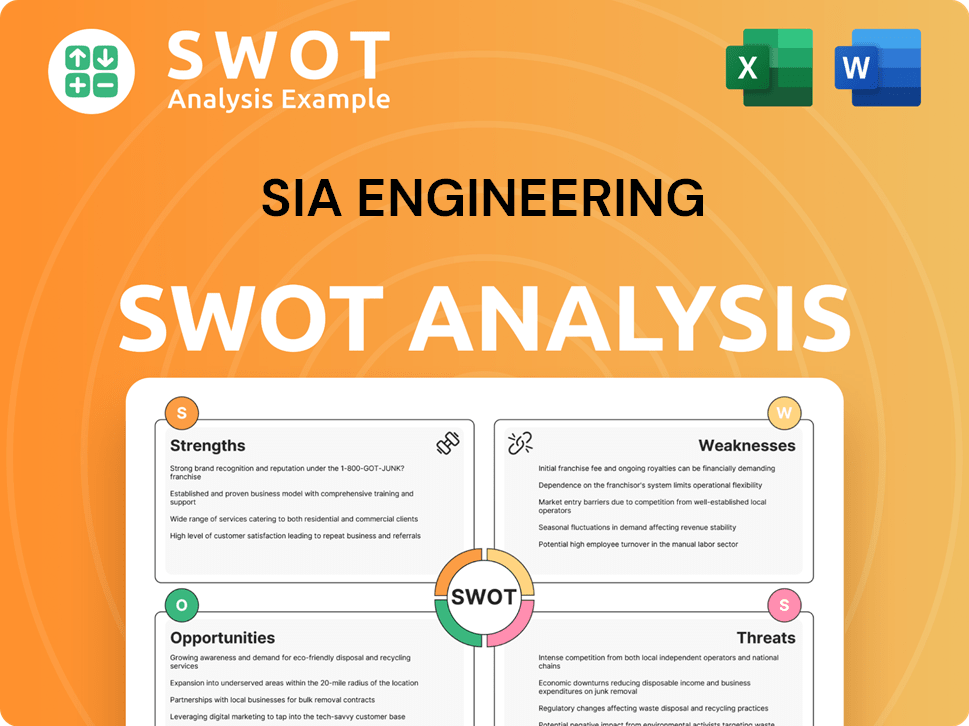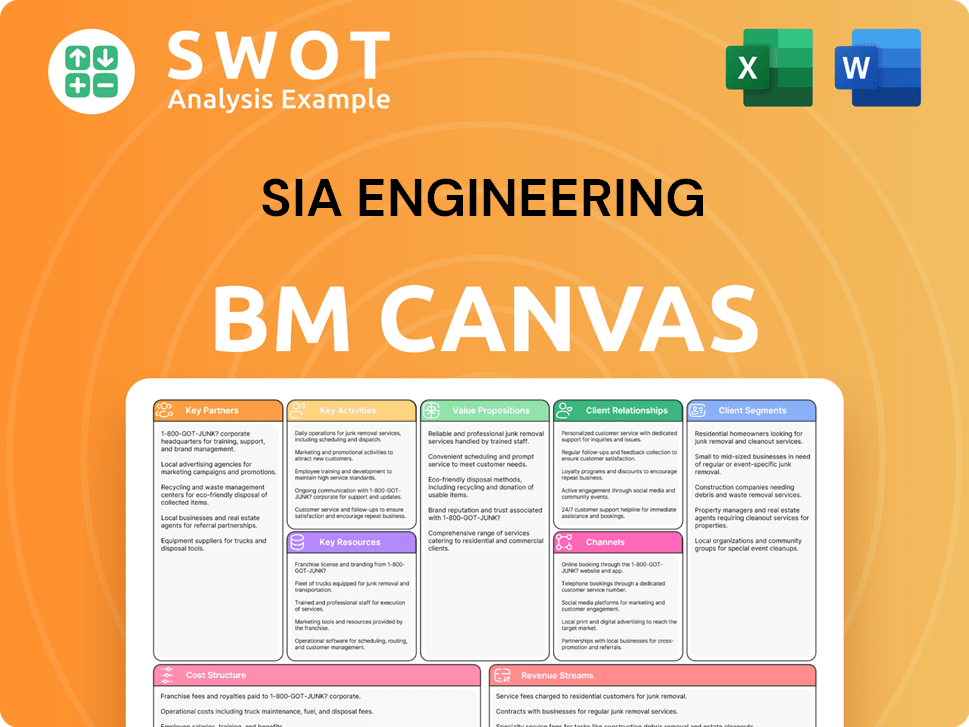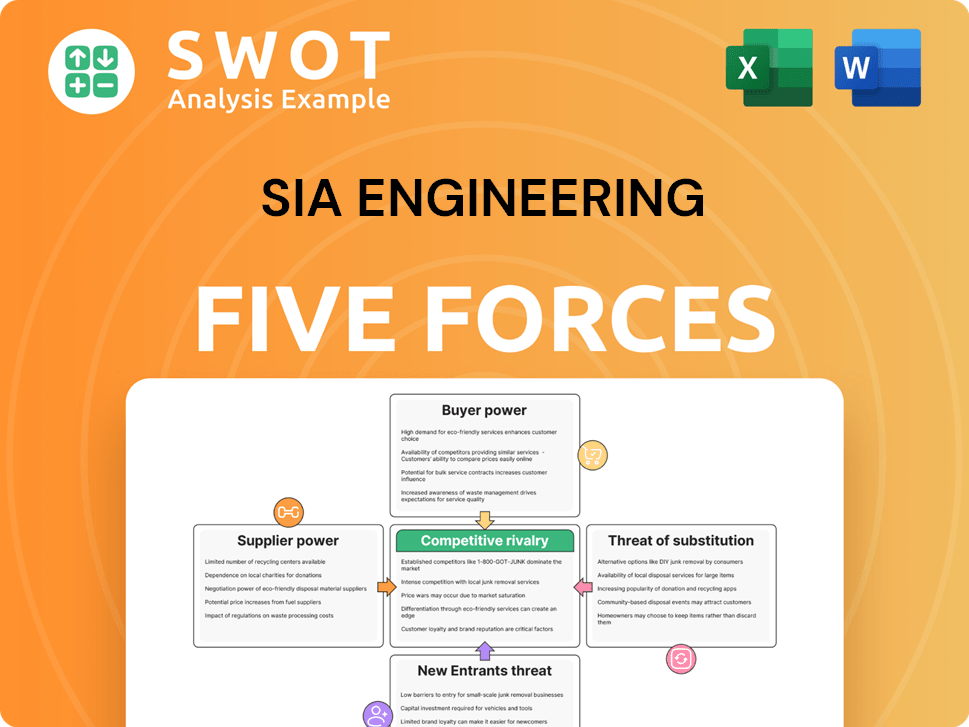SIA Engineering Bundle
Decoding SIA Engineering Company's Customer Universe: Who Flies with Them?
In the high-stakes world of aviation, understanding your clientele is paramount. For SIA Engineering SWOT Analysis, success hinges on a deep dive into its customer demographics and target market. This exploration unveils the crucial factors driving SIA Engineering Company's strategic decisions and market positioning in a dynamic global landscape.

This deep dive into SIA Engineering Company’s customer base provides a critical market analysis, revealing the intricate strategies behind their customer segmentation. Understanding the demographic breakdown of SIA Engineering Company clients and identifying the target market for aircraft maintenance services are key to unlocking sustained growth. Analyzing SIA Engineering Company's target market, including their geographic reach and ideal customer profile, offers invaluable insights for both investors and industry professionals seeking to understand the company's competitive edge and future prospects, including SIA Engineering Company service user demographics and customer acquisition strategies.
Who Are SIA Engineering’s Main Customers?
Understanding the customer demographics and target market of SIA Engineering Company (SIAEC) is crucial for grasping its strategic positioning within the aviation industry. SIAEC, as a provider of maintenance, repair, and overhaul (MRO) services, primarily operates within a business-to-business (B2B) framework. This means its focus is on serving other businesses, specifically those in the aviation sector.
The target market for SIAEC is mainly composed of airlines, aerospace manufacturers, and aircraft lessors globally. The company's customer segmentation is not based on traditional consumer customer demographics like age or gender. Instead, it's based on factors relevant to the aviation industry, such as fleet size, aircraft types, and operational needs. This approach enables SIAEC to tailor its services to meet the specific requirements of its diverse clientele.
A key aspect of SIAEC's market analysis involves identifying and catering to the needs of various airline segments. This includes full-service carriers, low-cost carriers, and cargo airlines. Additionally, the company serves aerospace manufacturers and aircraft lessors, providing a comprehensive suite of engineering services. This diversification allows SIAEC to maintain a strong presence in the global aviation market and respond effectively to changing industry dynamics.
SIAEC's main customers include a variety of airlines, such as full-service carriers, low-cost carriers, and cargo airlines. The company also serves aerospace manufacturers and aircraft lessors worldwide. These groups are crucial for SIAEC's revenue and growth.
Customer segmentation is determined by fleet size, aircraft types, operational routes, and MRO service needs. These factors help SIAEC customize its services. This approach ensures that SIAEC meets the specific demands of its diverse customer base effectively.
A significant portion of SIAEC's revenue comes from established, large-scale airlines that need comprehensive MRO services. Recent contracts, like the one with Scoot, highlight SIAEC's focus on supporting diverse airline operations. This includes airlines expanding their fleets with new-generation aircraft.
SIAEC adapts to evolving aviation trends by investing in capabilities for new aircraft types. The company focuses on component MRO and line maintenance services, reflecting the diverse needs of its airline customers. This adaptability is key in a constantly changing industry.
SIAEC's customer base is diverse, including airlines of various sizes and operational models. The company's focus on providing comprehensive MRO services to these airlines is a key aspect of its business strategy. The company's adaptability and investment in new technologies are crucial for maintaining its competitive edge in the aviation market.
- Large Airlines: These customers require extensive MRO services to maintain their large fleets, representing a stable revenue stream for SIAEC.
- Emerging Airlines: These airlines may need more flexible and tailored MRO solutions, offering growth opportunities for SIAEC.
- New Aircraft Types: SIAEC invests in capabilities for new aircraft, attracting airlines with modern fleets and expanding its service offerings.
- Component MRO and Line Maintenance: SIAEC focuses on these services to meet the diverse operational needs of its airline customers, ensuring comprehensive support.
SIA Engineering SWOT Analysis
- Complete SWOT Breakdown
- Fully Customizable
- Editable in Excel & Word
- Professional Formatting
- Investor-Ready Format

What Do SIA Engineering’s Customers Want?
Understanding the customer needs and preferences is crucial for SIA Engineering Company to thrive in the competitive aircraft maintenance, repair, and overhaul (MRO) market. The primary focus of SIA Engineering Company's customer demographics is on airlines, which have specific demands driven by operational efficiency, safety, and cost-effectiveness. This detailed analysis helps in refining market analysis and customer segmentation strategies.
Airlines seek partners who can minimize aircraft downtime, ensuring maximum operational hours and revenue. This leads to a strong preference for quick turnaround times, reliable component repairs, and efficient engine overhauls. Safety is paramount, with customers prioritizing MRO providers with impeccable safety records and adherence to international aviation standards. Therefore, SIA Engineering Company's target market is heavily influenced by these critical factors.
Purchasing behaviors are often shaped by long-term contracts, strategic partnerships, and proven track records of quality and reliability. Decision-making criteria include technical expertise, certifications, facility capabilities, global network, and competitive pricing. Airlines also value integrated solutions, consolidating various MRO services under one roof to streamline supply chain management. This comprehensive approach is a key aspect of SIA Engineering Company's customer profile.
Airlines prioritize minimal aircraft downtime to maximize operational hours and revenue. This drives the need for rapid turnaround times for maintenance checks, reliable component repairs, and efficient engine overhauls.
Safety is paramount, with customers seeking MRO providers with impeccable safety records and adherence to the highest international aviation standards. Regulatory compliance is a non-negotiable requirement.
Airlines are always looking for cost-effective solutions without compromising quality or safety. This includes competitive pricing, efficient maintenance processes, and extended aircraft lifespans.
Customers value MRO providers with strong technical expertise, certifications, and the ability to handle a wide range of aircraft types and engines. This includes advanced diagnostic capabilities.
The preference for integrated MRO solutions, encompassing various services under one roof, simplifies supply chain management. This includes line maintenance, engine overhaul, and component repair.
Airlines value MRO providers with a global network of facilities and line maintenance stations to support their operations worldwide. This ensures timely and convenient service.
Product/service usage patterns show a preference for predictive maintenance solutions and digital tools that enhance efficiency and transparency. Loyalty factors are built on consistent service quality, responsiveness, flexibility, and strong customer relationships. The psychological drivers include peace of mind, while practical drivers relate to cost savings and extended aircraft lifespans. Common pain points include unexpected aircraft grounding, high maintenance costs, and the need for specialized MRO capabilities. Feedback from customers influences product development and service enhancements. For instance, the increasing demand for sustainable aviation practices has led to the exploration of MRO solutions that support fuel efficiency and reduced emissions. SIA Engineering Company tailors its offerings through customized maintenance programs, investing in advanced diagnostic tools, and expanding its global network to serve specific airline routes and operational requirements. In 2024, the global MRO market was valued at approximately $89.8 billion, with forecasts indicating continued growth driven by increasing air travel and the need for aircraft maintenance. The Asia-Pacific region is expected to be a significant growth driver, reflecting the expansion of airline fleets and operations in the area.
Understanding these factors is critical for SIA Engineering Company to maintain its competitive edge and meet the evolving demands of its customer base. The following points summarize the key needs and preferences:
- Operational Efficiency: Minimizing aircraft downtime through rapid turnaround times and reliable service.
- Safety and Compliance: Adherence to the highest safety standards and regulatory requirements.
- Cost-Effectiveness: Competitive pricing and efficient maintenance solutions.
- Technical Expertise: Skilled workforce, certifications, and advanced diagnostic capabilities.
- Integrated Solutions: Comprehensive MRO services under one roof.
- Global Network: Extensive network of facilities and line maintenance stations.
SIA Engineering PESTLE Analysis
- Covers All 6 PESTLE Categories
- No Research Needed – Save Hours of Work
- Built by Experts, Trusted by Consultants
- Instant Download, Ready to Use
- 100% Editable, Fully Customizable

Where does SIA Engineering operate?
The geographical market presence of SIA Engineering Company is substantial, with a strategic focus on serving a diverse international clientele. Headquartered in Singapore, a major aviation hub, the company's operations span across key regions worldwide. Its major markets include Asia-Pacific, Europe, and the Americas, where it holds a strong market share, particularly in the Maintenance, Repair, and Overhaul (MRO) sector.
Differences in customer demographics, preferences, and buying power across these regions influence SIAEC's localized strategies. For instance, in rapidly growing aviation markets within Asia, there may be a higher demand for new aircraft MRO capabilities and faster turnaround times due to increasing fleet sizes and flight frequencies. In more mature markets like Europe and North America, the focus might be on specialized MRO services for aging fleets or advanced modifications and upgrades. Growth Strategy of SIA Engineering includes adapting to these regional demands.
Recent expansions and strategic withdrawals are often driven by market demand and competitive landscapes. SIAEC continuously evaluates opportunities to strengthen its footprint in high-growth regions or to divest from less strategic ventures. The geographic distribution of sales and growth is closely tied to global air traffic recovery patterns and airline fleet expansion plans.
The Asia-Pacific region represents a significant market for SIA Engineering Company, driven by the rapid growth in air travel and fleet expansion. This area demands new aircraft MRO capabilities and efficient turnaround times. The company's focus includes establishing partnerships to enhance regional capabilities and meet the increasing demand for aircraft maintenance services.
In Europe, SIA Engineering Company targets the market with specialized MRO services for aging aircraft fleets and advanced modifications. The focus is on providing high-value services to meet the needs of mature aviation markets. The company adapts its strategies to cater to the specific demands of this region, ensuring it remains competitive.
The Americas market is another key region for SIA Engineering Company, where it provides comprehensive MRO services. The company strategically positions itself to meet the diverse needs of airlines operating in this market. This involves adapting to the specific requirements of North and South American aviation sectors.
SIA Engineering Company forms joint ventures and partnerships to enhance its global presence. Recent collaborations, such as the one with Ametek Inc. and Tel-Instrument Electronics Corp., have led to the establishment of new facilities. These partnerships strengthen regional capabilities and support the company's growth strategy.
As of the financial year ended March 31, 2024, SIAEC's revenue from line maintenance increased by 44.8% to S$476.5 million, and its fleet management and component overhaul segment saw a 25.1% increase to S$292.8 million. This demonstrates robust revenue streams across its geographically distributed customer base.
- These figures highlight the company's strong performance and its ability to capitalize on the recovery in global air travel.
- The growth in line maintenance and fleet management indicates a broad-based recovery across its global operations.
- SIA Engineering Company's strategic approach to market segmentation and customer demographics has contributed to its financial success.
SIA Engineering Business Model Canvas
- Complete 9-Block Business Model Canvas
- Effortlessly Communicate Your Business Strategy
- Investor-Ready BMC Format
- 100% Editable and Customizable
- Clear and Structured Layout

How Does SIA Engineering Win & Keep Customers?
SIA Engineering Company (SIAEC) employs a comprehensive strategy for acquiring and retaining customers in the competitive aircraft maintenance, repair, and overhaul (MRO) industry. The company's approach is multi-faceted, leveraging its established reputation, extensive global network, and diverse service offerings to attract and keep clients. This involves a blend of direct sales, strategic partnerships, and a focus on long-term relationships.
For customer acquisition, SIAEC focuses on direct engagement with airlines and participation in major industry events. Given its business-to-business (B2B) model, building strong relationships with airline procurement teams and technical departments is crucial. Sales tactics often involve competitive bidding for MRO contracts, emphasizing the company's technical expertise, turnaround times, and cost-effectiveness. The company also leverages its relationships with aircraft manufacturers and lessors as referral channels to expand its customer base.
Customer data and CRM systems play a vital role in targeting campaigns and understanding customer needs, enabling personalized service proposals and proactive engagement. Segmentation allows SIAEC to tailor its marketing messages and service offerings to specific airline types or regions. For instance, a low-cost carrier might prioritize cost-efficiency and quick turnarounds, while a full-service legacy airline might value comprehensive service packages and advanced engineering support.
SIAEC's sales teams directly engage with airline procurement and technical departments. These engagements are crucial for securing MRO contracts and building long-term relationships. This approach ensures that SIAEC understands the specific needs of each customer and can tailor its services accordingly.
Participation in major aerospace trade shows and conferences, such as MRO Asia-Pacific and the Paris Air Show, is a key element of SIAEC's acquisition strategy. These events provide opportunities to showcase their services and network with potential clients. This helps to increase brand visibility and generate leads within the industry.
SIAEC forms strategic partnerships with aircraft manufacturers and lessors. These relationships serve as referral channels, providing access to a broader customer base. This collaborative approach enhances market reach and provides opportunities to expand its service offerings.
SIAEC actively participates in competitive bidding processes for MRO contracts. Their ability to demonstrate technical expertise, offer quick turnaround times, and provide cost-effective solutions is crucial in securing these contracts. This competitive approach drives efficiency and ensures quality service delivery.
Retention strategies are centered on delivering consistent, high-quality service and building long-term partnerships. This includes robust after-sales service, technical support, and transparent communication throughout the maintenance process. Loyalty programs in the MRO sector often manifest as long-term service agreements (LTSAs) or maintenance-by-the-hour (MBH) contracts, which provide predictable costs and guaranteed service levels for airlines. Personalized experiences are delivered through dedicated account managers and customized maintenance programs tailored to specific fleet requirements. One can gain more insight into SIAEC's business model by reading the Revenue Streams & Business Model of SIA Engineering.
LTSAs are a key retention strategy, providing airlines with predictable costs and guaranteed service levels. These agreements foster long-term partnerships and ensure a steady stream of revenue for SIAEC. They also allow for better resource planning and allocation.
MBH contracts offer airlines predictable costs based on flight hours, simplifying budgeting and maintenance planning. This model enhances customer satisfaction and builds loyalty. SIAEC's MBH contracts provide a reliable service and increase customer retention.
SIAEC assigns dedicated account managers to each customer to provide personalized service and build strong relationships. This ensures that customer needs are understood and addressed promptly. These managers act as a single point of contact, improving communication and satisfaction.
SIAEC develops customized maintenance programs tailored to the specific fleet requirements of each airline. These programs optimize maintenance schedules and reduce downtime. This personalized approach enhances operational efficiency and customer satisfaction.
Robust after-sales service and technical support are integral to SIAEC's retention strategy. This includes providing timely assistance and resolving any issues quickly. This commitment to customer support strengthens relationships and fosters loyalty.
SIAEC maintains transparent communication throughout the maintenance process, keeping customers informed about the status of their aircraft. This builds trust and ensures that customers are aware of the progress. This proactive approach enhances customer satisfaction.
SIA Engineering Porter's Five Forces Analysis
- Covers All 5 Competitive Forces in Detail
- Structured for Consultants, Students, and Founders
- 100% Editable in Microsoft Word & Excel
- Instant Digital Download – Use Immediately
- Compatible with Mac & PC – Fully Unlocked

Related Blogs
- What are Mission Vision & Core Values of SIA Engineering Company?
- What is Competitive Landscape of SIA Engineering Company?
- What is Growth Strategy and Future Prospects of SIA Engineering Company?
- How Does SIA Engineering Company Work?
- What is Sales and Marketing Strategy of SIA Engineering Company?
- What is Brief History of SIA Engineering Company?
- Who Owns SIA Engineering Company?
Disclaimer
All information, articles, and product details provided on this website are for general informational and educational purposes only. We do not claim any ownership over, nor do we intend to infringe upon, any trademarks, copyrights, logos, brand names, or other intellectual property mentioned or depicted on this site. Such intellectual property remains the property of its respective owners, and any references here are made solely for identification or informational purposes, without implying any affiliation, endorsement, or partnership.
We make no representations or warranties, express or implied, regarding the accuracy, completeness, or suitability of any content or products presented. Nothing on this website should be construed as legal, tax, investment, financial, medical, or other professional advice. In addition, no part of this site—including articles or product references—constitutes a solicitation, recommendation, endorsement, advertisement, or offer to buy or sell any securities, franchises, or other financial instruments, particularly in jurisdictions where such activity would be unlawful.
All content is of a general nature and may not address the specific circumstances of any individual or entity. It is not a substitute for professional advice or services. Any actions you take based on the information provided here are strictly at your own risk. You accept full responsibility for any decisions or outcomes arising from your use of this website and agree to release us from any liability in connection with your use of, or reliance upon, the content or products found herein.